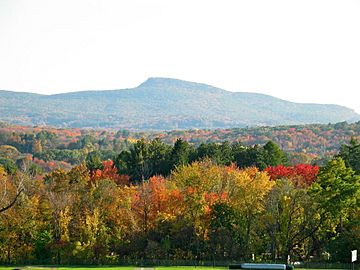Mount Norwottuck facts for kids
Quick facts for kids Mount Norwottuck |
|
|---|---|
| Mount Norwottock | |

Mount Norwottuck in the Mount Holyoke Range.
|
|
| Highest point | |
| Elevation | 1,106 ft (337 m) |
| Geography | |
| Location | Amherst and Granby, Massachusetts. |
| Parent range | Holyoke Range / Metacomet Ridge |
| Geology | |
| Age of rock | 200 Ma |
| Mountain type | Fault-block; igneous |
| Climbing | |
| Easiest route | Metacomet-Monadnock Trail |
Mount Norwottuck, also known as Mount Norwottock, is a tall mountain in Massachusetts. It stands about 1,106 feet (337 m) (337 meters) above sea level. This makes it the highest point in the Holyoke Range, which is a group of mountains made of a special rock called traprock. Mount Norwottuck is part of the larger Metacomet Ridge, a long chain of mountains stretching from Long Island Sound almost to the Vermont border. The mountain rises steeply, offering amazing views of the surrounding countryside. You can find Mount Norwottuck in the towns of Amherst and Granby, Massachusetts.
Contents
The Story Behind the Name
Mount Norwottuck got its name from a professor named Edward Hitchcock. He taught geology at Amherst College. In 1841, he came up with the term "Scenographical Geology." This term described the amazing geological features of the Holyoke Range.
The mountain was first called Hilliard Knob. But Professor Hitchcock decided to use the Native American name Norwottuck instead. Norwottuck was the name of a nearby Native American village.
Professor Hitchcock was also famous for his ideas about dinosaur tracks. He thought the tracks found in the area were made by an ancient type of bird. Scientists later learned that modern birds are related to prehistoric dinosaurs. A mountain peak west of Mount Norwottuck is named after him.
Exploring Mount Norwottuck
Mount Norwottuck has many miles of hiking trails. Two famous trails cross the mountain:
- The 114-mile (183 km) (183 km) Metacomet-Monadnock Trail
- The 47-mile (76 km) (76 km) Robert Frost Trail
From different open spots on the mountain, you can see wide views of the Pioneer Valley to the north. You can also spot the University of Massachusetts Amherst campus. A lower ridge to the east, called Rattlesnake Knob, is 813 feet (248 m) (248 meters) high. It also has great views from its rocky ledges.
The Horse Caves
Beneath the top of Mount Norwottuck are the Horse Caves. These are a series of rock overhangs made of sedimentary rock. People believe these caves were used as a hiding place by rebels during Shays' Rebellion.
Most of Mount Norwottuck is now protected. It's part of the Mount Holyoke Range State Park. Local groups and private owners also help to conserve the remaining land.
Nearby Mountains
From Mount Norwottuck, the Holyoke Range continues east as Long Mountain. To the west, it continues as Bare Mountain. There used to be another mountain to the west called Round Mountain. But it was removed by quarrying operations.
You can easily reach Mount Norwottuck from the Notch Visitors Center. Besides the Frost Trail and the Metacomet-Monadnock Trail, there are other local trails. These trails lead to the peak from the south side.
How Mount Norwottuck Formed
Mount Norwottuck, like many mountains in the Metacomet Ridge, is made of basalt. Basalt is also called traprock. It's a type of volcanic rock.
The mountain formed about 200 million years ago, near the end of the Triassic Period. This was when the North American continent began to pull away from Africa and Eurasia. As the continents separated, hot lava flowed up from deep underground. This lava cooled and hardened into thick layers of rock.
Later, faulting (cracks in the Earth's crust) and earthquakes caused these rock layers to tilt. This tilting created the dramatic cliffs and ridges you see on Mount Norwottuck today.
Unique Ecosystems
The mountain has different types of environments, called microclimates. These include:
- Hot, dry upper slopes
- Cool, moist ravines
- Rocky ledges rich in minerals from basalt talus (broken rock)
These different microclimates create special homes for plants and animals. You can find species here that are rare in other parts of Massachusetts.


